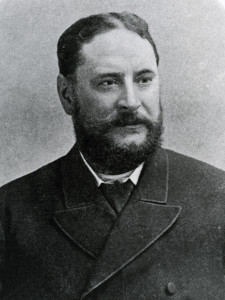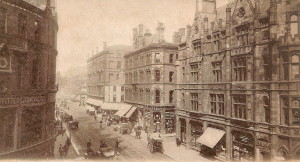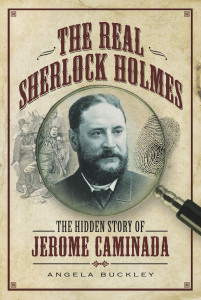
While Sherlock Holmes honed his forensic skills in Arthur Conan Doyle’s books, real Victorian detectives scoured dark alleys, beer houses, and even doctors’ offices to solve crimes. How did real investigators compare with the world’s most famous fictional sleuth?
Angela Buckley, author of The Real Sherlock Holmes: The Hidden Story of Jerome Caminada (Barnsley, England: Pen and Sword, 2014), joins us to pull back the curtains on the life of a real Victorian detective. Between 1870 and 1900, Jerome Caminada broke new ground as an investigator to become one of Manchester’s most legendary policemen. Angela also blogs about historical true crime on her website, Victorian Supersleuth.

Why the title, Angela? Was there any connection between Caminada, a Victorian detective, and the fictional Sherlock Holmes?
Angela Buckley: When I began researching the work of Jerome Caminada I soon realised that there were some startling similarities between his work as a detective and the cases of the great Sherlock Holmes. In fact, after Sir Arthur Conan Doyle began publishing his stories, Detective Caminada soon became known as ‘Manchester’s Sherlock Holmes’ as contemporary newspaper readers made a connection, so it seemed an appropriate title for the book.
Did Arthur Conan Doyle base Holmes on a real Victorian detective?
It’s well known that Sir Arthur Conan Doyle based his legendary character primarily on his mentor, Sir Joseph Bell. However, as an avid reader of the contemporary press, in which the cases of real-life detectives were regularly reported, Sir Arthur would have been aware of the more prominent figures, like Jerome Caminada.
How did the Victorian detective differ from the fictional Holmes?
Real Victorian detectives, like Jerome Caminada, investigated a much wider range of crimes and criminals than Sherlock Holmes, although their work was often less glamorous. Detective Caminada’s knowledge of his city would have been far more extensive, and he would have relied more heavily on his contacts on both side of the law. However, Caminada did use many similar strategies to Holmes, including disguise, deduction and keen observation.
Your book is also a portrait of Victorian Manchester. Could tell us what the back alleys and dark streets were like?
In the 19th century, Manchester had some of the worst slums in the country. At the heart of the city was a labyrinth of dark alleys and closed courts, with cramped back-to-back terrace houses with no sanitation or ventilation. A no-go area for respectable people; the rookeries had gin shops, illegal beer houses and brothels, and they housed thieves, con artists and many other shady characters.

What kind of cases did Caminada work on?
Detective Caminada worked on all manner of cases, including pickpockets, charlatans, political agitators and even murderers. A man with a strong social conscience, he exposed many scams that exploited ordinary people, such as the quack doctors who sold fake potions to individuals worried about their health.
How did he display his investigatory genius?
Like Sherlock Holmes, Detective Caminada had excellent powers of deduction, which he displayed most effectively in his signature case, the Manchester Cab Mystery. When a businessman was found dead in a cab, Caminada deduced that his death was linked to illegal prize-fighting in the city and it took him just three weeks to bring the perpetrator to justice.
Terrorism and gang warfare are nothing new. Caminada had to deal with them also. What they were like in Caminada’s time?
Detective Caminada dealt with many organised attacks. He worked undercover for the British government tracking Fenian suspects, during the dynamite campaign of the 1880s, when Irish nationalists targeted public buildings throughout the UK. In Manchester, he tackled gangs of vicious street fighters, known as ‘scuttlers’, who terrorised the streets with violent turf wars. He also faced groups of anarchists, who led protests during periods of unrest.

You mention Caminada acting as a prosecutor and conducting cross examinations. Was it usual for a Victorian detective to assume functions of prosecutor?
The British criminal justice system evolved considerably during the 19th century and in the earlier decades, it was usual for the victim of a crime to act as prosecutor, as few had access to a lawyer, except in capital offences. Later, the state conducted all prosecutions. In the latter half of the century, police courts took more responsibility for trying minor cases and police officers were engaged in the process. When a magistrate decided not to pursue a case, an officer like Caminada could take it further as a private individual, which he did on occasion.
So who was the better detective, Jerome Caminada or Sherlock Holmes?
Great question – predictably I’d have to say Caminada, as he obviously solved ‘real’ cases!!
Thanks so much for joining us, Angela!
How realistic do you think Sherlock Holmes’s cases and investigative techniques were?



